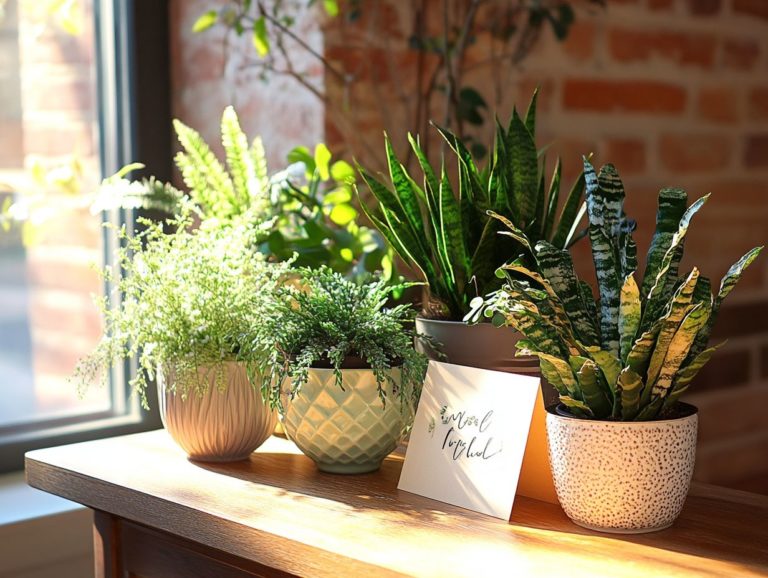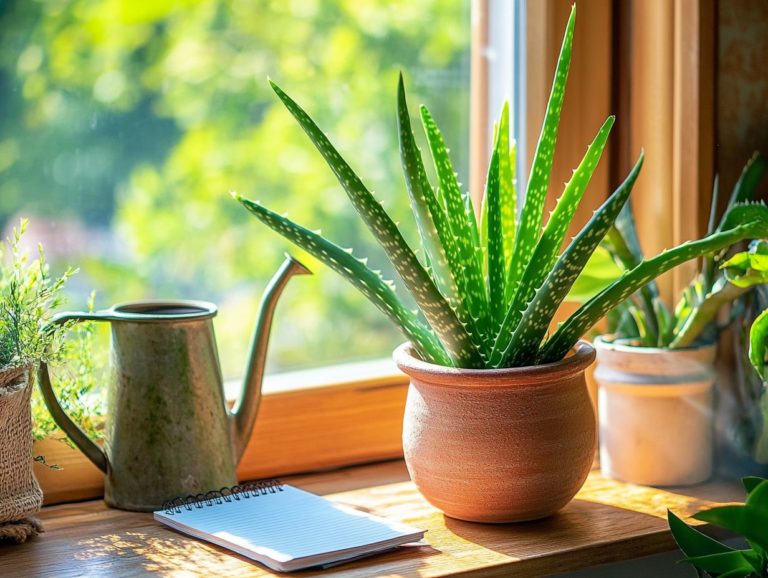Caring for Peace Lilies: Tips and Tricks
Peace Lilies, also known as Spathiphyllum, are more than mere decorations in your home; they bring peace and beauty, transforming your space into a serene oasis.
To ensure these stunning plants flourish, proper care is paramount. Discover the ideal environment for your Peace Lily, including its light, temperature, and humidity requirements.
Master the art of watering and feeding with these handy tips. Identify common pests and diseases, and explore simple tips for cutting and growing new plants.
With these handy tips at your fingertips, you ll be fully prepared to nurture your Peace Lily to its utmost potential and enjoy its beautiful blooming flowers.
Contents
Key Takeaways:
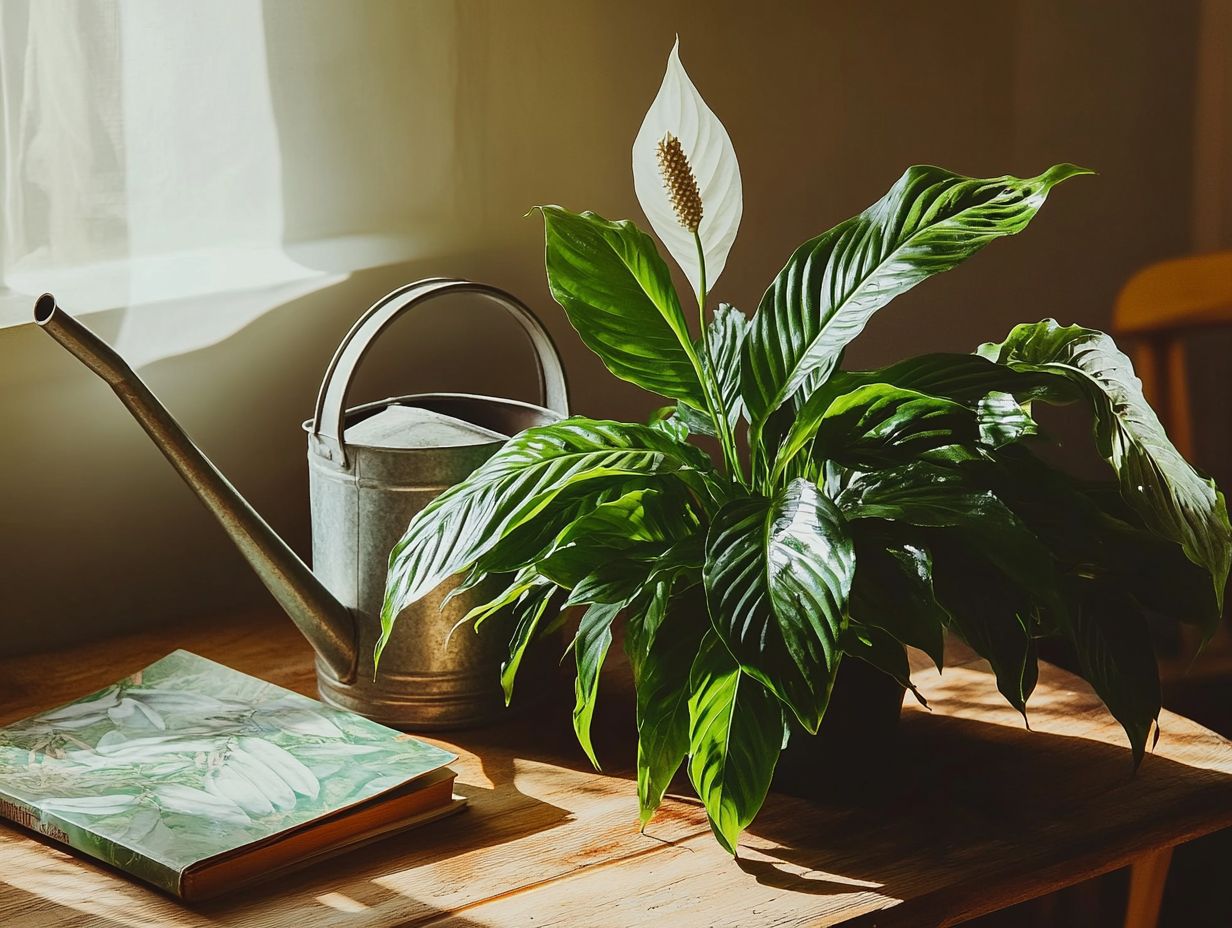
- Keep your peace lily in a warm, humid environment with indirect light to promote healthy growth and ensure its stunning flower spathes bloom beautifully.
- Water and feed your peace lily carefully, allowing the soil to dry slightly between waterings and using a balanced fertilizer every 2-3 months.
- Regularly prune and propagate your peace lily to maintain its health and promote new growth. Pay attention to potential pests like aphids and spider mites and diseases such as root rot, caused by overwatering, where roots start to decay and can harm your plant, and take appropriate measures to treat them.
Overview of Plant Characteristics
Peace lilies, scientifically known as Spathiphyllum, are the indoor plants you ve likely seen gracing elegant spaces with their lush green foliage and striking white flower spathes, reminiscent of a sailboat in full bloom. Hailing from the tropical rainforests of South America, these beauties thrive in indirect light and are often chosen not just for their aesthetic appeal but also for their air-purifying qualities, making them a popular choice among indoor gardening enthusiasts.
With their remarkable attributes, peace lilies enhance the ambiance of your indoor spaces while positively impacting your wellbeing, making them a favorite among indoor gardening aficionados.
Beyond their visual allure, peace lilies exhibit impressive adaptability to varying humidity levels and can tolerate a bit of neglect, making them the perfect low-maintenance companions for busy households. Ideally, they flourish in well-drained potting soil enriched with nutrient supplements and prefer moderate watering, allowing the soil to dry slightly between each drink.
This adaptability extends to their exceptional ability to filter harmful toxins from the air, improving indoor air quality a significant benefit for healthier living environments.
Their elegant blooms can last for several weeks, infusing any room with a touch of sophistication and tranquility. It s easy to see why peace lilies have become a staple in modern home decor.
Create the Perfect Home for Your Peace Lily
Crafting the perfect environment for your peace lily is essential for its growth and longevity. This tropical beauty flourishes when its specific needs for light, temperature, and humidity are met.
Position your peace lily in a spot with indirect light, and pay attention to humidity levels while using well-draining soil. These steps are crucial for nurturing its development and preventing complications such as root rot.
The Best Conditions for Your Peace Lily
For optimal growth, peace lilies need specific light, temperature, and humidity conditions that closely replicate their native tropical rainforest habitat. They thrive in indirect light and high humidity levels.
Make sure your peace lily enjoys the right temperature range ideally between 65 F and 85 F to greatly enhance its overall health and encourage those stunning blooms.
Positioning the plant in a spot with consistent temperatures will help you avoid stress, which often leads to wilting or yellowing leaves. Maintaining elevated humidity levels, ideally around 50-60%, is also crucial, as peace lilies flourish in moisture-rich environments.
Employing a pebble tray or a humidifier, or even using rainwater, can help you achieve this. The delicate balance of these factors not only nurtures your plant but also prevents common issues like root rot, ensuring the leaves remain vibrant and lush, allowing those beautiful blooms to thrive.
Watering and Feeding Your Peace Lily
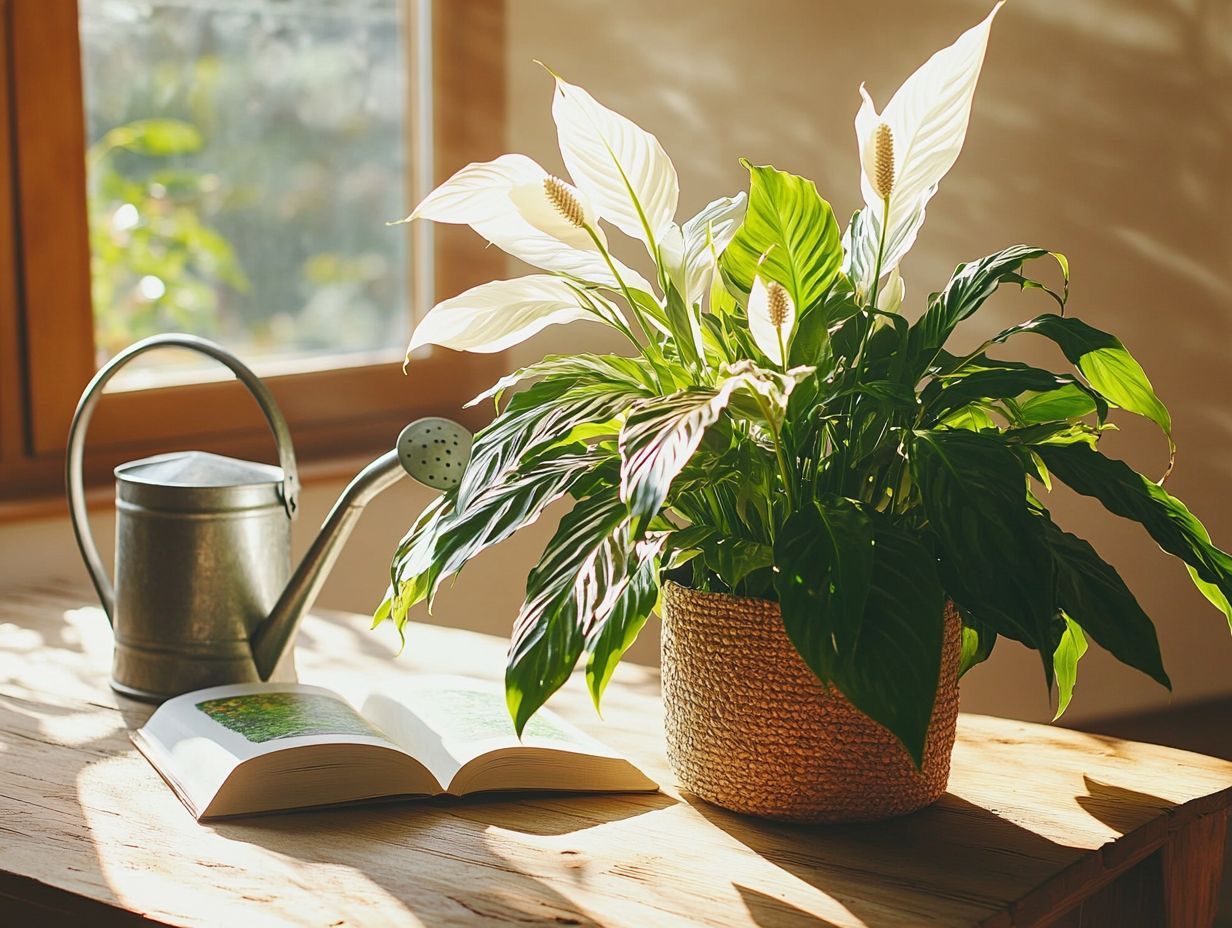
To ensure the health of your peace lily, it’s crucial to adopt proper watering and feeding practices using liquid fertilizer. These elements help prevent root rot and promote vibrant blooms.
For watering, allow the top inch of soil to dry out before giving it a drink. During the growing season, use liquid fertilizer to provide essential nutrients for your plant to thrive.
Proper Techniques and Frequency
To keep your peace lily thriving, mastering the art of watering is essential. Pay close attention to frequency; improper care can lead to yellowing leaves that signal stress.
Water your peace lily thoroughly, allowing excess water to drain away. For more detailed care, check out peace lily varieties: a care overview. Let the soil dry out somewhat before the next watering.
A simple way to gauge moisture is to insert your finger about an inch into the soil. If it feels dry, it’s time to give your plant a drink. In damp and humid seasons, you may want to cut back on watering, as too much moisture can invite root rot. In dry conditions or warmer months, keep a closer eye on the plant and consider increasing the watering frequency.
Stay attuned to your plant’s environment, watching for signs of distress like yellowing leaves. Adjusting your care will keep your peace lily vibrant and healthy.
Common Pests and Diseases for Peace Lilies
Just like any indoor plant, your peace lilies can fall prey to various pests and diseases that threaten their growth and well-being. It s important for you to stay alert.
Keep an eye out for common culprits like spider mites and aphids. Be wary of diseases such as root rot, often stemming from overwatering or inadequate drainage. Spotting issues early can save your peace lily.
Identification and Treatment
Identifying and treating pests and diseases affecting your peace lily is essential for maintaining its health and vitality. Regularly inspect your plant for pests like aphids and spider mites to take timely action.
By closely examining the leaves and stems for discoloration or webbing, you can easily spot signs of trouble. Yellowing leaves or stunted growth may indicate underlying issues, possibly linked to nutrient deficiencies or disease.
For treatment, both organic methods such as neem oil or insecticidal soap and chemical treatments can effectively relieve infestations. If symptoms of disease arise, use a fungicide to treat fungal infections.
Act quickly to treat infestations to protect your peace lily. Staying informed about your plant’s needs and acting swiftly will help you maintain effective pest management and promote healthy growth.
Pruning and Propagating Peace Lilies
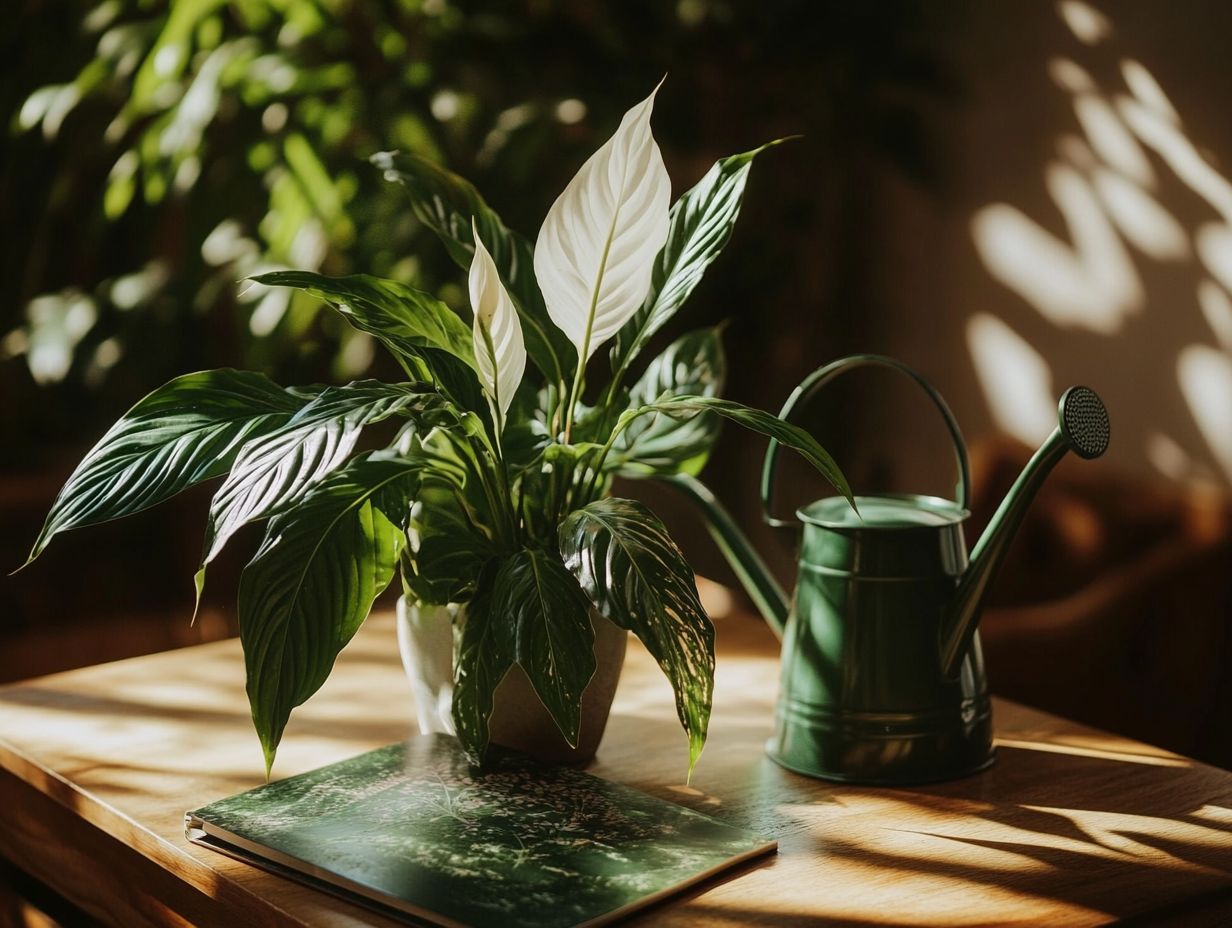
Pruning and propagating peace lilies are essential practices that elevate your plants’ vibrancy and encourage robust growth, especially during the ideal repotting season in spring.
By regularly pruning the leaves, you can eliminate any yellowing or damaged foliage, enhancing the plant’s overall health and aesthetic. This not only contributes to a more polished appearance but also sets the stage for effective propagation, should you wish to expand your collection.
Methods for Maintaining Healthy Plants
To keep your peace lilies healthy, commit to regular care. Simple tasks like pruning and ways to grow new plants are key to their growth while reducing stress on the plant.
Timing plays a vital role in pruning. Tackling this task in the spring encourages new growth as the plant emerges from dormancy. Remove any yellowing leaves and spent blooms to enhance the plant’s appearance and redirect energy to healthier areas.
Regarding propagation, division is a favored technique best performed every couple of years. This rejuvenating process allows your peace lily to flourish even more. To learn more about this method, check out our guide on how to propagate peace lilies. By integrating these approaches, you can significantly enhance the overall health and vitality of your peace lily, transforming it into a captivating focal point in any room.
Tips and Tricks for Caring for Peace Lilies
Caring for peace lilies demands more than just a basic understanding; it calls for expert insights that can truly enhance your indoor gardening experience.
By grasping essential care tips and employing integrated practices, such as proper light exposure and maintaining humidity, you can create an ideal environment for your peace lily to thrive and reward you with its exquisite blooms.
Expert Advice for Optimal Growth and Blooming
For your peace lily to flourish, it’s essential to understand its unique needs, especially regarding light exposure near bright windows and optimal humidity levels. Implementing customized care strategies will allow you to enjoy its elegant blooms and lush foliage.
Place your peace lily in a spot that receives bright, indirect sunlight avoid direct rays that could scorch its delicate leaves. Maintaining a humidity level around 50-60% is vital. You can achieve this through regular misting or by using a humidifier.
As the seasons shift, adjust your watering frequency and provide the right nutrients to promote growth. Pay attention to how your peace lily responds; this will guide you in refining your care routine, ensuring robust health and vibrant displays in your indoor oasis.
Frequently Asked Questions
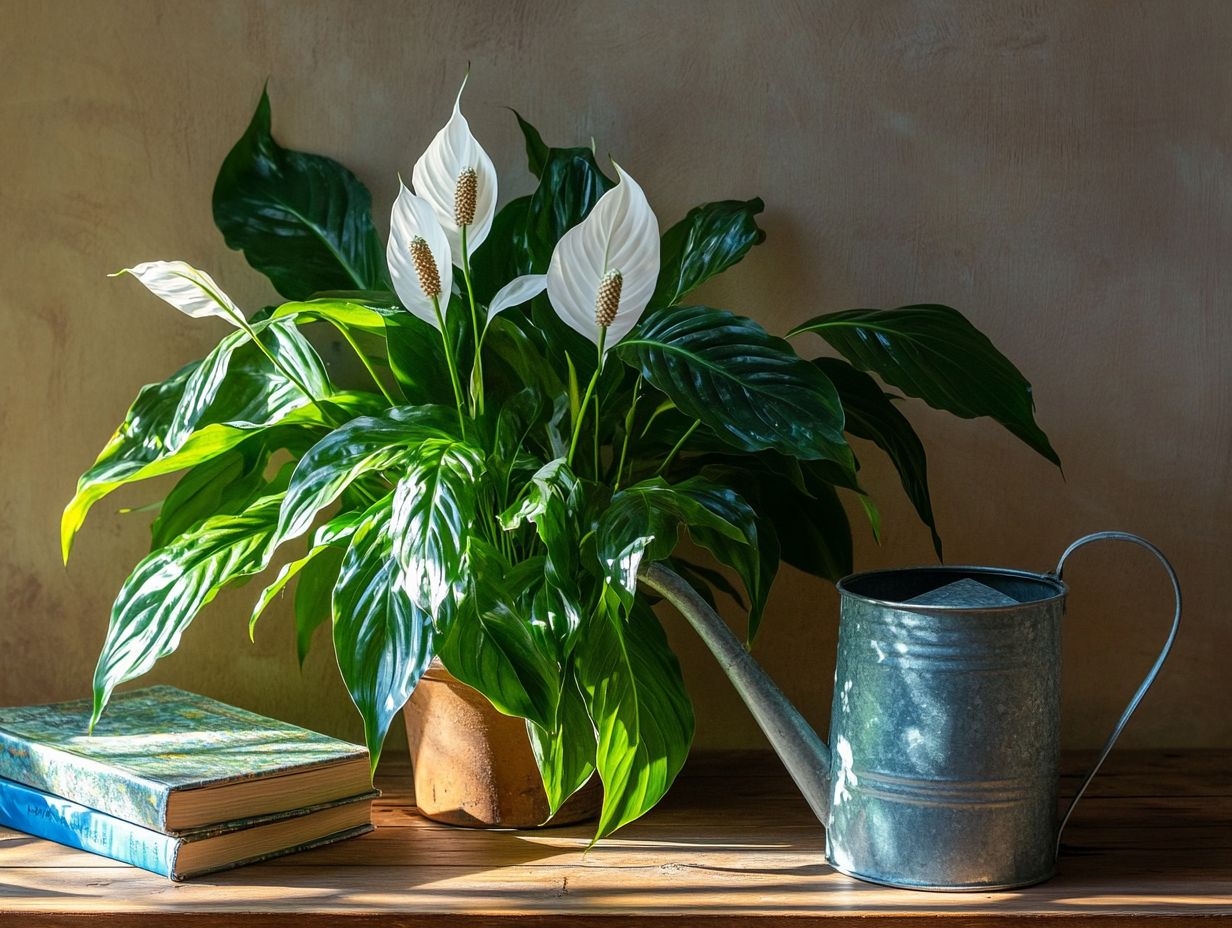
How often should I water my peace lilies?
Peace lilies should be watered once a week or when the top inch of soil is dry. Avoid overwatering, as it can lead to root rot.
What is the best location for my peace lilies?
Peace lilies prefer bright, indirect light. While they can tolerate low light, too much direct sunlight can damage their leaves.
How do I know if my peace lily needs to be repotted?
If your peace lily has outgrown its current pot or if the roots are starting to appear on the surface, it’s time to repot. Repotting should be done every 1-2 years.
Can I fertilize my peace lilies?
Yes, you can fertilize your peace lilies during the growing season (spring and summer). Use a balanced liquid fertilizer diluted to half strength.
What are some common pests that can affect peace lilies?
Mealybugs and spider mites are common pests that can attack peace lilies. Check your plant regularly for signs of infestation and treat accordingly.
Can I propagate my peace lilies?
Yes, peace lilies can be propagated through division during repotting. Simply separate the plant into smaller sections with their own roots and repot them in fresh soil.
We’d love to hear about your peace lily care experiences! Share your tips or questions in the comments below.
Summary of Main Care Tips:
- Water weekly or when the top inch of soil is dry.
- Place in bright, indirect sunlight.
- Maintain humidity around 50-60%.
- Repot every 1-2 years.
- Fertilize during the growing season.


